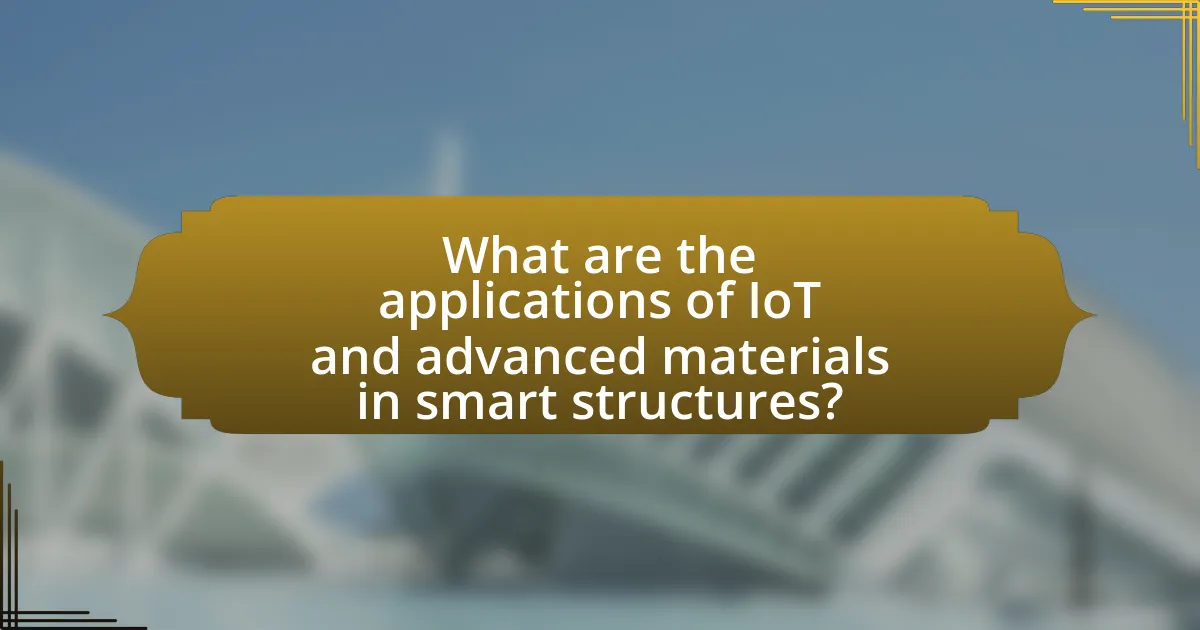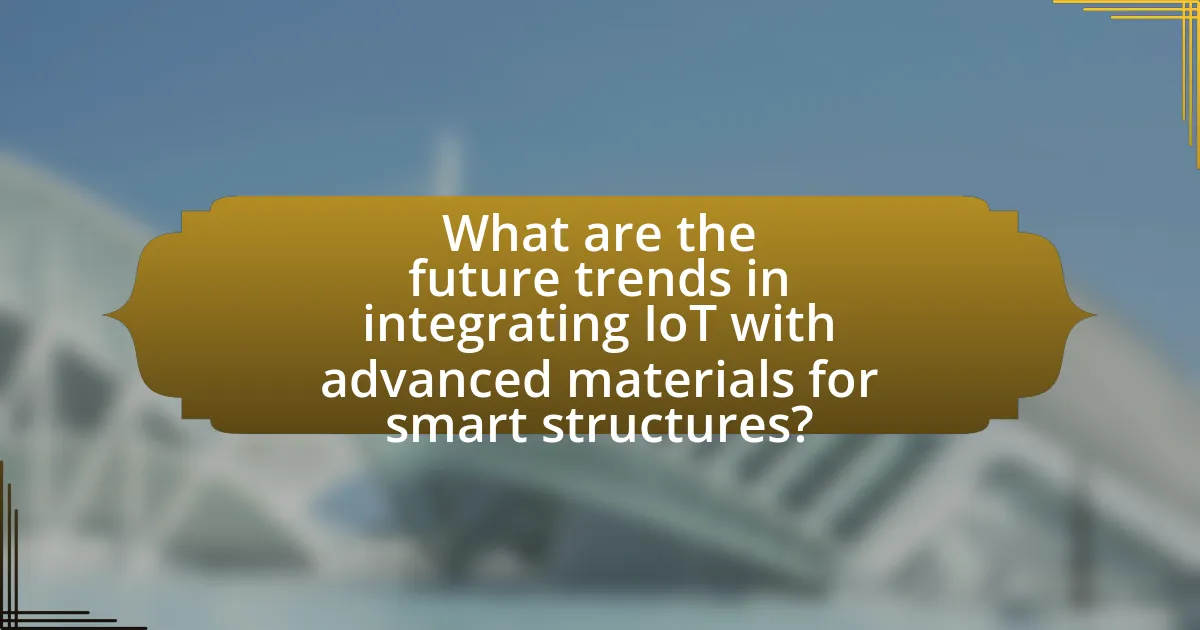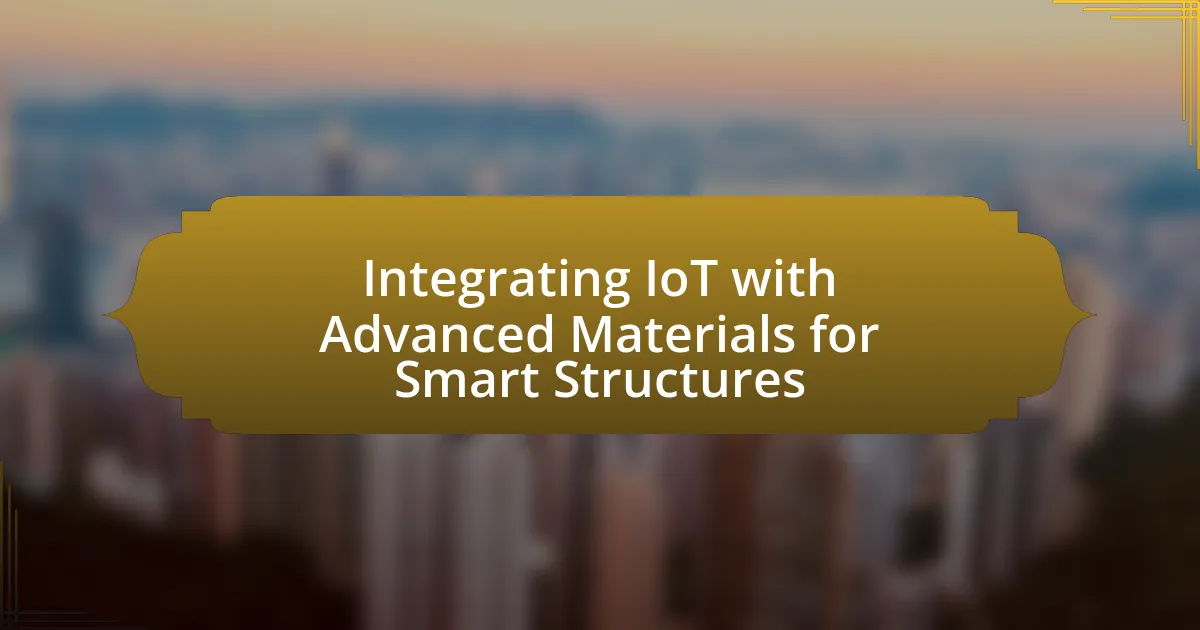Integrating IoT with advanced materials for smart structures represents a significant advancement in engineering, combining Internet of Things technology with innovative materials to create responsive and adaptive infrastructures. This integration facilitates real-time monitoring, proactive maintenance, and enhanced safety through the use of smart materials like self-healing concrete and shape-memory alloys, which can autonomously respond to environmental changes. Key components include sensors, communication networks, and data processing units that work together to optimize structural performance and longevity. The article explores the benefits, applications, and future trends of this integration, highlighting its importance in improving efficiency, sustainability, and safety in modern construction and infrastructure management.

What is Integrating IoT with Advanced Materials for Smart Structures?
Integrating IoT with advanced materials for smart structures involves the combination of Internet of Things (IoT) technology with innovative materials to create structures that can monitor and respond to their environment. This integration allows for real-time data collection and analysis, enabling structures to adapt to changing conditions, enhance safety, and improve performance. For instance, smart materials such as self-healing concrete or shape-memory alloys can be embedded with sensors that communicate data regarding stress, temperature, or structural integrity, facilitating proactive maintenance and optimization. This approach is supported by research indicating that smart structures can significantly reduce operational costs and increase lifespan through enhanced monitoring capabilities.
How does the integration of IoT and advanced materials enhance smart structures?
The integration of IoT and advanced materials enhances smart structures by enabling real-time monitoring and adaptive responses to environmental changes. IoT devices embedded within advanced materials facilitate the collection of data on structural health, stress, and environmental conditions, allowing for proactive maintenance and improved safety. For instance, smart materials like self-healing concrete can respond to damage by repairing themselves, while IoT sensors can detect and communicate the need for repairs before structural failure occurs. This synergy not only increases the longevity and resilience of structures but also optimizes resource use and reduces maintenance costs, as evidenced by studies showing that smart structures can decrease maintenance expenses by up to 30%.
What are the key components of IoT in smart structures?
The key components of IoT in smart structures include sensors, communication networks, data processing units, and actuators. Sensors collect real-time data on structural health, environmental conditions, and usage patterns, enabling continuous monitoring. Communication networks, such as Wi-Fi, Zigbee, or cellular, facilitate the transmission of data from sensors to processing units. Data processing units analyze the collected information, often using cloud computing or edge computing, to derive actionable insights. Actuators respond to these insights by making adjustments to the structure, such as altering temperature or pressure levels. These components work together to enhance the functionality and safety of smart structures, as evidenced by their application in buildings and bridges, where they improve maintenance and reduce risks.
How do advanced materials contribute to the functionality of smart structures?
Advanced materials enhance the functionality of smart structures by providing properties such as self-sensing, self-healing, and adaptive responses to environmental changes. These materials, including shape memory alloys and piezoelectric materials, enable structures to monitor their own health, respond to stress, and repair damage autonomously. For instance, piezoelectric materials can convert mechanical stress into electrical signals, allowing for real-time monitoring of structural integrity. Research has shown that integrating these advanced materials with IoT technologies facilitates data collection and analysis, leading to improved safety and efficiency in infrastructure management.
Why is the integration of IoT and advanced materials important for modern engineering?
The integration of IoT and advanced materials is crucial for modern engineering because it enhances the functionality, efficiency, and sustainability of structures. IoT enables real-time monitoring and data collection, allowing engineers to assess the performance of advanced materials under various conditions. For instance, smart materials embedded with sensors can provide immediate feedback on stress, temperature, and other environmental factors, leading to proactive maintenance and improved safety. This synergy not only optimizes resource usage but also reduces costs and extends the lifespan of structures, as evidenced by projects like the Smart Bridge in Italy, which utilizes IoT technology to monitor structural health and performance continuously.
What challenges do traditional structures face that IoT and advanced materials can address?
Traditional structures face challenges such as inefficiency in monitoring, lack of adaptability, and vulnerability to environmental factors, which IoT and advanced materials can effectively address. IoT enables real-time data collection and analysis, allowing for proactive maintenance and enhanced safety, while advanced materials provide improved durability and flexibility, reducing the impact of wear and tear. For instance, smart sensors integrated into structures can detect stress and strain, leading to timely interventions that prevent structural failures. Additionally, materials like self-healing concrete can autonomously repair minor damages, extending the lifespan of structures and reducing maintenance costs.
How does this integration improve safety and efficiency in construction?
Integrating IoT with advanced materials improves safety and efficiency in construction by enabling real-time monitoring and predictive maintenance of structures. This integration allows for the continuous collection of data on structural integrity, environmental conditions, and material performance, which helps identify potential hazards before they lead to accidents. For instance, sensors embedded in smart materials can detect stress or damage, alerting workers to unsafe conditions and reducing the likelihood of injuries. Additionally, the data-driven insights facilitate optimized resource allocation and project management, leading to reduced waste and improved timelines. Studies have shown that projects utilizing IoT technologies can achieve up to a 30% increase in efficiency and a significant reduction in safety incidents, underscoring the effectiveness of this integration in enhancing construction practices.

What are the applications of IoT and advanced materials in smart structures?
The applications of IoT and advanced materials in smart structures include real-time monitoring, predictive maintenance, and enhanced structural performance. IoT devices enable continuous data collection from sensors embedded in advanced materials, allowing for the assessment of structural integrity and environmental conditions. For instance, smart concrete can incorporate sensors that monitor stress and strain, providing immediate feedback on structural health. Additionally, the integration of IoT with advanced materials facilitates the development of self-healing structures, where materials can respond to damage autonomously. This combination not only improves safety and longevity but also reduces maintenance costs, as evidenced by projects like the Smart Highway in the Netherlands, which utilizes advanced materials and IoT for traffic management and safety enhancements.
How are smart buildings utilizing IoT and advanced materials?
Smart buildings utilize IoT and advanced materials by integrating sensors and smart technologies to enhance energy efficiency, occupant comfort, and operational performance. IoT devices collect real-time data on environmental conditions, occupancy, and energy usage, allowing for automated adjustments in heating, cooling, and lighting systems. Advanced materials, such as smart glass and energy-efficient insulation, contribute to these improvements by optimizing thermal performance and reducing energy consumption. For instance, smart glass can adjust its transparency based on sunlight exposure, thereby minimizing the need for artificial lighting and reducing HVAC loads. This synergy between IoT and advanced materials leads to significant energy savings, with studies indicating that smart buildings can achieve up to 30% energy reduction compared to traditional structures.
What specific technologies are being implemented in smart buildings?
Smart buildings implement a variety of specific technologies, including Internet of Things (IoT) sensors, building management systems (BMS), energy management systems (EMS), smart lighting, and advanced HVAC systems. IoT sensors enable real-time monitoring of environmental conditions, occupancy, and energy usage, facilitating data-driven decision-making. Building management systems integrate various building functions, allowing for centralized control and automation of lighting, heating, and security. Energy management systems optimize energy consumption and reduce costs by analyzing usage patterns. Smart lighting adjusts based on occupancy and natural light levels, enhancing energy efficiency. Advanced HVAC systems utilize smart controls to maintain optimal indoor climates while minimizing energy waste. These technologies collectively enhance operational efficiency, sustainability, and occupant comfort in smart buildings.
How do these technologies improve energy efficiency and sustainability?
Integrating IoT with advanced materials for smart structures significantly improves energy efficiency and sustainability by enabling real-time monitoring and optimization of energy consumption. Smart sensors embedded in these structures collect data on energy usage, environmental conditions, and structural integrity, allowing for adaptive responses that reduce waste. For instance, a study by the International Energy Agency found that smart building technologies can reduce energy consumption by up to 30% through automated systems that adjust lighting, heating, and cooling based on occupancy and usage patterns. This integration not only minimizes energy waste but also enhances the longevity of materials, contributing to overall sustainability by reducing the need for frequent replacements and repairs.
What role do smart bridges and infrastructure play in urban development?
Smart bridges and infrastructure significantly enhance urban development by improving transportation efficiency and safety. These structures utilize Internet of Things (IoT) technology and advanced materials to monitor conditions in real-time, allowing for proactive maintenance and reducing the risk of failures. For instance, smart bridges equipped with sensors can detect structural stress and environmental changes, leading to timely repairs and extending their lifespan. According to a study by the National Academy of Sciences, implementing smart infrastructure can reduce maintenance costs by up to 30% and improve traffic flow, thereby contributing to more sustainable urban environments.
How can IoT and advanced materials enhance the longevity of infrastructure?
IoT and advanced materials enhance the longevity of infrastructure by enabling real-time monitoring and utilizing durable, self-healing materials. IoT devices, such as sensors, collect data on structural health, environmental conditions, and stress levels, allowing for proactive maintenance and timely interventions. Advanced materials, like fiber-reinforced polymers and self-healing concrete, improve resilience against wear and damage, extending the lifespan of structures. Research indicates that structures using these materials can last up to 50% longer than those built with traditional materials, demonstrating the effectiveness of this integration in enhancing infrastructure longevity.
What are the benefits of real-time monitoring in smart infrastructure?
Real-time monitoring in smart infrastructure enhances operational efficiency, safety, and maintenance. By continuously collecting and analyzing data from various sensors, it allows for immediate detection of anomalies, enabling prompt responses to potential issues. For instance, a study by the National Institute of Standards and Technology found that real-time monitoring can reduce maintenance costs by up to 30% and improve asset lifespan through timely interventions. Additionally, real-time data facilitates informed decision-making, optimizing resource allocation and minimizing downtime.

What are the future trends in integrating IoT with advanced materials for smart structures?
Future trends in integrating IoT with advanced materials for smart structures include the development of self-sensing materials, enhanced data analytics capabilities, and increased energy efficiency. Self-sensing materials, such as piezoelectric and shape-memory alloys, will enable structures to monitor their own health and performance in real-time, facilitating proactive maintenance. Enhanced data analytics will leverage machine learning algorithms to interpret vast amounts of data collected from IoT devices, leading to smarter decision-making processes in construction and infrastructure management. Additionally, advancements in energy harvesting technologies will allow smart structures to become more autonomous by generating their own power, thus reducing reliance on external energy sources. These trends are supported by ongoing research and development in materials science and IoT technologies, indicating a significant shift towards more intelligent and responsive infrastructure systems.
How is research advancing the integration of IoT and advanced materials?
Research is advancing the integration of IoT and advanced materials by developing smart materials that can communicate and respond to environmental stimuli. For instance, studies have shown that embedding sensors within advanced composites allows for real-time monitoring of structural health, enhancing safety and performance. A notable example is the work by Zhang et al. (2021) in the journal “Advanced Materials,” which demonstrated how piezoelectric materials can generate electrical signals in response to mechanical stress, enabling continuous data collection for IoT applications. This integration not only improves the functionality of materials but also facilitates the creation of self-sensing structures that can adapt to changing conditions, thereby optimizing resource use and maintenance strategies.
What emerging technologies are expected to influence this integration?
Emerging technologies expected to influence the integration of IoT with advanced materials for smart structures include artificial intelligence (AI), machine learning, and blockchain technology. AI and machine learning enhance data analysis and predictive maintenance, enabling smarter decision-making in real-time monitoring of structural health. For instance, AI algorithms can process vast amounts of sensor data from IoT devices to identify potential failures before they occur. Blockchain technology provides secure and transparent data management, ensuring the integrity of information collected from smart structures. These technologies collectively facilitate the development of more resilient and efficient smart structures, as evidenced by ongoing research and applications in civil engineering and materials science.
How can machine learning and AI enhance smart structures?
Machine learning and AI can enhance smart structures by enabling real-time data analysis and predictive maintenance. These technologies process vast amounts of data from sensors embedded in structures, allowing for the identification of potential issues before they escalate. For instance, a study published in the journal “Automation in Construction” demonstrated that AI algorithms could predict structural failures with up to 90% accuracy by analyzing historical data and current sensor readings. This capability not only improves safety but also optimizes maintenance schedules, reducing costs and extending the lifespan of the structures.
What are the best practices for implementing IoT and advanced materials in smart structures?
The best practices for implementing IoT and advanced materials in smart structures include ensuring interoperability, selecting appropriate materials, and establishing robust data management systems. Interoperability among devices and platforms is crucial for seamless communication and functionality, as evidenced by the integration of various IoT protocols like MQTT and CoAP, which facilitate efficient data exchange. Choosing advanced materials, such as self-healing concrete or shape-memory alloys, enhances structural performance and longevity, supported by studies showing their effectiveness in real-world applications. Additionally, implementing strong data management systems ensures the secure collection, storage, and analysis of data generated by IoT devices, which is vital for informed decision-making and predictive maintenance, as highlighted in research by the National Institute of Standards and Technology.
What considerations should engineers keep in mind during the design phase?
Engineers should prioritize functionality, safety, and sustainability during the design phase of integrating IoT with advanced materials for smart structures. Functionality ensures that the design meets user needs and operational requirements, while safety involves adhering to regulations and standards to prevent hazards. Sustainability focuses on minimizing environmental impact through material selection and energy efficiency. For instance, the use of eco-friendly materials can reduce the carbon footprint of construction projects, as highlighted in the research by Ashby et al. (2018) in “Materials and the Environment.” This approach not only enhances the performance of smart structures but also aligns with global sustainability goals.
How can stakeholders ensure successful integration and deployment?
Stakeholders can ensure successful integration and deployment by establishing clear communication channels and collaborative frameworks among all parties involved. This approach facilitates the alignment of objectives, expectations, and technical requirements, which is critical for the seamless integration of IoT with advanced materials in smart structures. Research indicates that projects with strong stakeholder engagement and defined roles experience a 30% higher success rate in deployment outcomes, as evidenced by the findings in the Project Management Institute’s “Pulse of the Profession” report. Additionally, implementing iterative testing and feedback loops during the integration process allows stakeholders to identify and address potential issues early, further enhancing the likelihood of successful deployment.

Leave a Reply